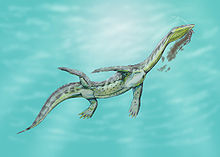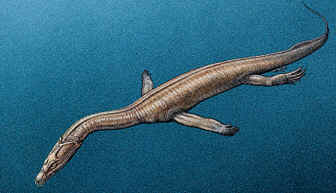Ceresiosaurus
Ceresiosaurus, live reconstruction
- Europe ( Switzerland )
- C. calcagnii Peyer, 1931
- C. lanzi Haenni, 2004
Ceresiosaurus is a fossil genus wasserbewohnender reptiles from the middle and upper Triassic.
Fund history
The first Ceresiosaurus - fossil was discovered in 1931 at the Monte San Giorgio in southern Switzerland and described by the Swiss paleontologist Bernhard Peyer. By the year 2004 eight further copies were found in this area. There are known two types, Ceresiosaurus calcagnii and Ceresiosaurus lanzi. The name refers to the Ceresiosaurus Ceresio, the Italian name of Lake Lugano, which is located at the foot of Monte San Giorgio.
System
The genus Ceresiosaurus is classified in the group of nothosaurs. The genus itself is controversial because it Lariosaurus (named after Lario, Lake Como ) and Silvestrosaurus are two very similar genres. The construction of the limbs of Ceresiosaurus but very different from the other genera which a separate genus justified.
Olivier Rieppel suggested that Ceresiosaurus is a synonym for Lariosaurus.
Features & lifestyle
The representatives of Ceresiosaurus lived in the Middle Triassic in the Tethys lagoons in a subtropical climate. With a length of 2 to 3 meters, they were one of the largest vertebrates in this ecosystem.
Your physique was well adapted to the marine life. The limbs are formed into fins and have no externally visible toes longer. The skull is the shortest of all nothosaurs. These properties are already very similar to those of plesiosaurs occurring later.
C. calcagnii is the older style and has massive vertebrae. The younger species C. lanzi was better adjusted by a slight -built skeleton without thickened ribs and a shorter tail in more open water. You could dive deeper and swim faster, thus utilizing other habitats.










